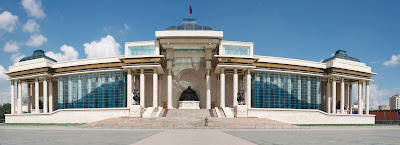I managed to visit two wilderness spots in Mongolia, the first was a hiking trail into the mountains south of Ulaanbaatar and the second Gorkhi-Terelj National Park. The first spot is called Bogdkhan National park, this is directly south of Ulaanbaatar.
To get here, you can take a bus south from the city center and then walk about 30 minutes to the trailhead. The base of the mountain is rolling fields, mostly grass and some flowers. The trail up through the mountain follows a small river and quickly turns into a forest.The trail is clearly marked with these yellow flags.
At what I think was the summit of this mountain are large fields and some trees. Compared to Ulaanbaatar, it's really quiet up here.
If this is the summit, it's about 914 meters (3000 feet) above the city 2261 meters above sea level. Basically, this was my training for climbing Mt. Fuji. This park is a UNESCO world heritage site and the oldest national park in the world.
The base of the mountain was a small Ger village, these are traditional Mongolian nomad houses.
I was able to visit Gorkhi-Terelj national park. I hired a car in Ulaanbaatar to take me round trip to the park, below is the dash of the car. On the dash was a solar powered buddhist spinning prayer wheel.
The park has perfect lawn, as dose most of northern Mongolia. The lawn is nice because the nomads moves herds of horses, cows, sheep and goats around to keep the grass in check. There is not one mechanical lawn mower in this country.
Through out the park are small villages and places you can camp.
I think these are wild horses, but they might just be normal horses grazing between the time of working... But they look wild.
This is a very famous huge rock in the national park. If you look close, you can see it is shaped like a turtle.
All around the turtle rock is rental horses and camels.
Here is another view of the turtle rock, you can get an idea of how large it is.
This is the car and driver who gave me a ride to the national park. Really nice guy, Mongolia is a left hand drive country. But left hand drive is not really enforced, so he had a right had drive car from Japan... The ride to and from the park was scary.
Horse management.
I took a photo on a horse, but I did not really ride it around anywhere. Poor horse.
Some kids with their camel.
This river ran through the middle of the park, it was a really beautiful view that was difficult to capture with a photo.


















































